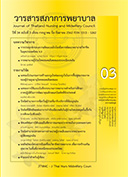Factors Predicting Shock in Emergency Patients
Keywords:
co-morbidity, Shock Index, emergency patients, Emergency Severity Index, ageAbstract
Objective: To study the factors of age, comorbidity, time spent on transporting patients to hospital, type of transport service and emergency severity, and their power to predict shock in emergency patients.
Design: Correlational predictive design.
Methodology: The sample was 200 patients with physical illnesses or injuries treated at two suburban tertiary hospitals. Six instruments were used to collect data: 1) a personal information questionnaire; 2) an illness/injury form; 3) a form recording the transport time, transport service type and treatment/care given during transport; 4) a comorbidity assessment form; 5) the Emergency Severity Index (ESI); and 6) the Shock Index (SI). The data were analysed using chi-square and binary logistic regression analysis, with the statistical signifcance level determined at 0.05.
Results: The patients’ average age was 52.04 years (SD = 21.78; range = 18-93 years). Sixty-three percent of the patients were treated for illnesses, and over half (54%) had comorbid diseases. In nearly half of the cases (48.5%), the patients had been transported to hospital by their friends or relatives. In three-fourths of the cases (75.5%), the transporting time had exceeded 60 minutes, and the patients (76.5%) had not received medical treatment or care during transportation. More than half (53.5%) suffered from shock; of these, 43% (SI > 0.8) were already in shock upon admission.
The patients’ shock was found to be correlated with the factors of age, comorbidity, type of transport and symptomatic severity. In addition, emergency severity level 1 (critical) and level 2 (high-risk) displayed signifcant shock-predicting powers, at Nagelkerke R2 = .296 (OR = 35.198, 95% CI = 7.726-160.351, p < 0.01; and OR = 4.545, 95% CI = 1.498-13.786, p < 0.05, respectively).
Recommendations: It is recommended that emergency unit nurses apply the ESI and SI to assessing trauma patients’ emergency severity to prevent shock in patients with physical illnesses and injuries.
Downloads
References
Geneva 2015;1:12-30.
2. National Institute of Emergency Medicine.Annual report 2559: Nonthaburi: National Institute of Emergency Medicine 2017;36.(in Thai)
3. Holler JG, Henriksen DP, Mikkelsen S, Rasmussen LM, Pedersen C, & Lassen AT. Shock in the emergency
department: a 12 year population based cohort study. Scand J Trauma Resusc Emerg Med 2016;87:1-11.
4. WilmotLA. Shock: early recognition and management. Emerg Nurs J 2010;36:134-9.
5. Wacker DA, & Winters ME. Shock. Emerg Med Clin North Am 2014;32:747-58.
6. Brown JB, Gestring ML, Forsythe RM, Stassen NA, Billiar TR, Peithman AB, & Sperry JL. Systolic blood pressure criteria in the National Trauma triage protocol for geriatric trauma: 110 is the new 90. J Trauma
Acute Care Surg 2015;78:352-59.
7. Hasler RM, Nuesch E, Juni P, Bouamra O, Exadaktylos AK, & Lecky F. Systolic blood pressure below 110
mmHg is associated with increased mortality in blunt major trauma patients: multicentre cohort study. Resuscitation 2011;82:1202-7.
8. Brasel KJ, Guse C, Gentilello LM, & Nilura R. Heart rate: is it truly a vital sign? J Trauma 2007;62:812-7.
9. Allgower M, & Buri C. Schock Index. Dtsch Med Wochenschr 1967;92:1947-50.
10. Rady MY, Nightingale P, Little RA, & Edwards JD. Shock Index: a re-evaluation in acute circulatory
failure. Resuscitation 1992;23:227-34.
11. Gilboy N, Tanabe P,Travers D, & Rosenau AM. Emergency Severity Index (ESI).A triage tool for
emergency department care version 4.Implement handbook 2012.4thed.Rockville: Agency for Healthcare Research and Quality;2012.
12. Llompart-Pou JA, Perez-Barcena J, Chico-Fernandez M, Sanchez-Casado, M, & Raurich JM. Severe trauma in the geriatric population. World J Crit Care Med 2017;6:99-106.
13. Narula T, Raman D, Wiesen J, Choudhary C, Reddy AJ, & Moghekar A. A patient with acute COPD
exacerbation and shock. Chest;144:e1-3.
14. Harmsen AMK, Giannakapoulos GF, Morebeek PR, Jansma EP, Bonjer HJ., Bloemers FW.The influence
of prehospital time on trauma patients outcome: a systematic review.Injury 2015;46:602-9.
15. Al-Shaqsi S. Model of international Emergency Medical Service(EMS)systems. Oman Med J
2010;25:319-23.
16. Walker M, Spivak M, & Sebastian M. The impact of aging physiology in critical care. Crit Care Nurs
Clin North Am 2014;26:7-14.
17. Faul F, Erdfelder E,Bunchner A,Lang AG. G*Power version 3.1.7.9.2 [computer software]. 2013 [cited 2017
Oct 19] Available from: https://www.statisticsolution. com//logistic-regression-2-2-tailed.
18. Grozdanovski K, Milenkovic Z, Demiri I, & Spasovska K. Prediction of outcome from community-acquired
severe sepsis and septic shock in tertiary-care university hospital in a developing country. Crit Care Res Pract 2012;1:1-6.75
18. Navaratnarajah A, & Jackson SHD. The physiology of ageing. Med 2017;45:6-10.
19. Hwabejire JO, Nembhard CE, Oyetunji TA, Seyoum T, Abiodum MP, Siram SM, et al. Age-related mortality in blunt traumatic hemorrhagic shock: The killers and the life saves. J Surg Res 2017;213:199-206.
20. Mirhaghi A, Kooshiar H, Esmaeili H, & Ebrahimi M. Outcomes for Emergency Severity Index triage implementation in the emergency department. J Clin Diagn Res 2015;9:4-7.
21. Junnaruemit K, Thosingha O, Chayaput P, Toskulkaw T. Correlation between adult patients’ emergency room
discharge destination and the factors of physiological deterioration severity, age, and comorbidity. Thai J
Nurs Res 2016;31:123-32.
22. Park YH, Kang GH, Song BG, Chun WJ, Lee JH, Hwang SY, et al. Factors related to prehospital time delay in acute ST-segment elevation myocardial infarction. J Korean Med Sci 2012;27:864-9.
23. Glunkwamdee N, Thosingha O, Danaidussadeekul S, Praditsuktavorn B. Factors related to land traffc
accident injury victims’ access to medical care. Thai J Nurs Res 2015;30:54-66.
24. Katsakun A, Thosingha O, Chayaput P, Chaotawee D. Factors predicting injury outcome in emergent
phase among adults with traumatic injuries. Thai J Nurs Res 2011;26:4:30-42.
25. Kirshenbom D, Zaken ZB, Albilya N, Niyibizi E, Bala M. Older age, comorbid illnesses, and injury severity
affect immediated outcome in elderly trauma patients. J Emerg Trauma Shock 2017;10:146-50.
26. Pornsirirat T, Naayutaya SK, Pinyopasakul W, Thongyu S. Factors predicting septic shock in
septicemia medical patients. Thai J Nurs Res 2015;30:72-85..
27. Binthaisong T, Panpakdee O, Orathai P, Ratanakorn D. Factors related to onset arrival time in patients
with acute stroke. Kuakarun J Nurs 2013;20:15-29.
28. Hansudewechakul N, Chenthanakij, Wittayachamnankul B. Why don’t Chiangmai people in need call emergency
medical service?.J Health System Res 2012;6: 268-77.
29. Fuller G, Woodford M, Lawrence T, Coats T, & Lecky F. Do prolonged primary transport times for
traumatic brain injury patients result in deteriorating physiology? A cohort study. Prehosp Emerg Care.








